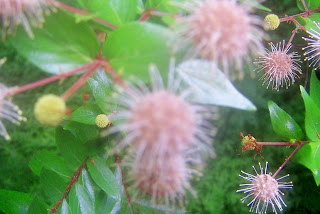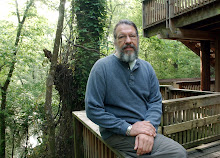marshy lake edges are perfect natural habitat for
buttonbush, shown here on the right, set apart from the lake edge
proper by a swath of marsh grasses
Let's have a closer look at a couple of more representatives from the Rubiaceae that make excellent ornamental garden plants down here: buttonbush (Cephalanthus occidentalis) and Chinese buttonbush (Adina rubella).
Buttonbush is a wetland native throughout much of eastern North America, as well as parts of the midwestern and southwestern U.S. Here in Louisiana it is a common inhabitant in just about every swamp and lake edge in just about every parish. Ecologically, it functions as a much-desired nectar plant for bees, butterflies, etc. Its main claim to fame in the bird world is as perhaps the most critically important natural nesting substrate (platform) for mid-sized wading birds such as Little-blue Heron, Cattle Egret, Great Egret, and others. Size-wise buttonbush ranges 6-15' in height. It is almost always multi-stemmed, and produces a spreading, umbrella-like crown. Its leaves are large, medium-pale green, and satin-finished.
native buttonbush (Cephalanthus occidentalis) blooms & foliage
blooms are between ping-pong and golf balls in size
foliage is at least 4" long
In garden settings, I include at least one “specimen” buttonbush in just about every design I execute – especially those with low-elevation spots that naturally attract moisture. In such cases, I “limb-up” the plant's stems, removing all lower branches up to a height of at least 6' thus exposing the plant's curvy, serpentine, pale-gray stems. This also aids in developing a denser-foliaged and more “bloomiferous” crown. Give this plant as much sun and as much moisture as possible.
The second featured buttonbush – Chinese buttonbush (aka “glossy adina”) – is similar to our native, but is visually far more refined in texture, due primarily to its very tiny, dark-green, and lusterously glossy leaves. Its blooms are also way smaller and more numerous than our native species, and with a flesh-pink tinge and delicate fragrance to boot. Like our native, Chinese buttonbush grows 6-15' and is spreading-crowned in form; but it normally produces many more stems than does our native buttonbush – giving it more of a “large shrub” (as opposed to “small tree” with native buttonbush) habit. Butterflies and bumblebees love the blooms.
Chinese buttonbush (Adina rubella) blooms & foliage
blooms are marble-sized
(pardon the stupid focus, ya'll....just concentrate to the right side of the frame)
[attempted] close-up of Adina rubella's fragrant pink blooms






Buttonbushes are truly wonderful plants in a garden to attract wildlife. Last summer, I started about 80 of them to use to rebuild a rookery island since herons will nest in the and many species of water birds eat the seeds.
ReplyDeleteAnd while they grow well in water, I've also seen them growing in a crack in rock in a dry creek bed and in yards where they survive drouth without extra water. One master gardener from San Marcos, Texas started a buttonbush from a cutting and told me she hadn't watered it during several months of dry, extra hot weather, and it was doing fine.
So this has the potential to be used in more places than just wet ones. And it sometimes gets covered with several species of butterflies, adding to it's beauty.
Anything that is really easy to grow has the potential to destroy native species. And when a foreign plant takes over, it can cause many other species to become extinct, including bugs and birds that are necessary to the food net.
I would hate to see the Chinese version become an invasive. I'm retired and work as a volunteer and have seen lots of time and money spent by many people in an effort to just control introduced plant and animal species. And we'll never be able to completely get rid of anything that has gone out of control. The tallows were the trees that either grew back from their roots after Hurricane Ike pushed 18 feet of water over them and saturated the soil with salt, preventing most life from growing for two years, or which sprouted in many new places.
I hope it doesn't become invasive either. Folks on the west coast are concerned about debris from the tsunami that hit Japan carrying invasive species.
DeleteHumans have really done a number - usually inadvertently - on whole ecosystems; even leading to the extinction of certain species by introducing a plant or animal that didn't belong there. Brown snakes in Hawaii, pythons in the Everglades, zebra mussels in the Great Lakes; Kudzu, Hydrilla, etc... There are too many examples to cover. Makes me sad
Some nurseries carry a special section of "native" plants, but usually not very many. What is the best source for an extensive list of native species, so we can consider the best varieties for native landscaping?
ReplyDelete